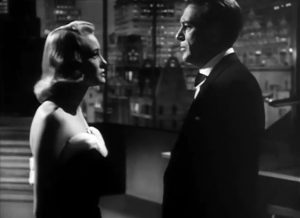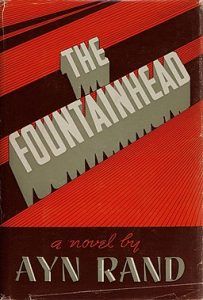TW // Rape
When Ayn Rand was twelve years old, her father’s pharmacy was seized by communists during Russia’s 1917 October Revolution. It was an event, according to Jennifer Burns, that Rand would never forget, and was a staple in forming her pro-Capitalist, anti-Communist philosophy of Objectivism. Rand did not write her books on Objectivism until the 1960s, but she first delivered its message through her works of fiction. In 1943, twenty-five years after the loss of her father’s business, Ayn Rand, who was by then a successful screenwriter in California, published The Fountainhead. The novel champions individualism through its protagonist Howard Roark but some of his actions are incredibly problematic. Because of this, The Fountainhead has always been a controversial book.
The Fountainhead’s main characters, Howard Roark and Peter Keating, are two architects who could not be more different from one another. Keating’s popularity in the architectural world means he quickly gains money and fame. In contrast, Roark is ridiculed for his outlandish designs (which would now be considered modernist) and his refusal to let other architects contribute to his work. But Keating and Roark also have opposite moral codes. Keating frequently deceives others in order to advance his career and status, tricking other characters into losing their jobs and even giving up his wife. Ironically, his most successful designs have elements borrowed from Roark, who is happy to let his ideas go uncredited. Roark himself constantly turns down projects because they conform to classical conventions of architecture rather than his own modernist style, even though this results in him falling into poverty and briefly having to give up architecture. I initially found Roark’s stubbornness irritating, especially when it caused him to suffer so much. However, in the lengthy descriptions of Roark’s few commissioned buildings, Rand shows how they not only have unique and memorable features but are ultimately designed to best suit the needs of their inhabitants. The gratification of the people who commissioned these buildings is a testimony to this.
And here, one of the main messages of The Fountainhead comes through: the best creations which give the most joy to others, are, paradoxically, the ones that were created entirely by the individual. As Roark himself says: ‘Every form of happiness is private. Our greatest moments are personal, self-motivated, not to be touched. The things which are sacred or precious to us are the things we withdraw from promiscuous sharing.’
If the idea of creating art for one’s own happiness was the main focus of The Fountainhead, the novel may have been more well-received. However, Rand extends her philosophy of self-interest beyond creating art to the way we live our lives. This creates some extremely problematic moments which change how the book can be viewed. One of the most obvious is when the novel’s heroine Dominique Francon is raped by Roark, yet Rand claims that Dominique enjoyed the experience: ‘she had found pleasure in the things which had happened.’ After the rape scene, Dominique muses on how she is attracted to Roark because he is motivated by self-interest to get whatever he desires. Here, Rand unintentionally reveals an obvious flaw in the philosophy of self-interest and individualism that she encourages: if we, like Roark, act entirely according to our own interests, we will inevitably hurt others in the process. This scene meant that I detested Roark for the rest of the novel even though Rand models him as the character that the reader is supposed to like.

(via Wikimedia Commons) Gary Cooper and Patricia Neal, who played Howard Roark and Dominique Francon in the film adaptation of The Fountainhead
Another problematic moment is in a speech Roark makes at the end of the novel which goes on for a whopping eight pages. As usual, Roark advocates individualism and placing the self above others. He praises the USA, saying, ‘This country was not based on selfless service, sacrifice, renunciation, or any precept of altruism. It was based on a man’s right to pursuit of happiness.’ However, considering that Roark’s ‘civilised’ America has a long history of slavery, the truth is the exact opposite of what he says. This is an example of how Rand’s determination to promote individualism means that she has to ignore the facts of history in order to do so.
The Fountainhead is a novel of extremes. On one side, there is Roark and the select few characters who align with his views of an individualism so extreme that they do not believe they have a duty to help anyone else. On the other side are Rand’s ‘antagonists’: those who believe that everyone should be selfless with all actions being done for the common good. A middle ground where people do things for themselves but also for others – which seems closest to the reality of our lives – is not considered. Although Rand’s views on individualism have some degree of merit with regards to the creation of art, they seem far from applicable to the way we live our lives, where compassion towards others is vital.
Featured image: Victor via Unsplash

